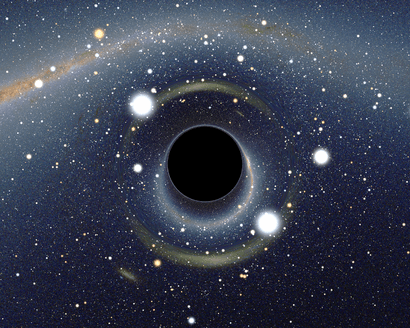Hawking radiation facts for kids

Hawking radiation is a special kind of energy that comes from black holes. It's like a faint glow that black holes are thought to give off. This idea comes from quantum effects, which are tiny, weird rules that particles follow near the edge of a black hole, called the event horizon.
This amazing idea was first suggested by a famous scientist named Stephen Hawking in 1974. He figured out that black holes aren't completely "black" after all!
Hawking radiation makes black holes slowly lose their mass and energy. Because of this, scientists sometimes call it "black hole evaporation." If a black hole loses more mass than it gains (for example, by swallowing stars or gas), it will slowly shrink. Eventually, it could even disappear completely!
Tiny black holes, sometimes called micro black holes, are expected to give off much more radiation than bigger ones. This means they should shrink and vanish much faster.
Contents
What is Hawking Radiation?
Hawking radiation is a type of black body radiation. This means it's like the heat and light given off by anything that has a temperature, even though black holes are super cold inside. The radiation happens because of strange quantum rules that play out very close to the black hole's edge, the event horizon.
How Does It Work?
Imagine space near a black hole. Even in empty space, tiny particles and antiparticles are constantly popping into existence and then disappearing again. This happens all the time!
Normally, these pairs of particles cancel each other out. But near a black hole's event horizon, something different can happen. One particle from the pair might fall into the black hole, while the other escapes into space. The escaping particle is what we call Hawking radiation. It carries away a tiny bit of the black hole's energy.
Why Do Black Holes Shrink?
Because Hawking radiation carries away energy, it means the black hole is slowly losing mass. Think of it like a pot of water slowly evaporating. The water molecules escape as steam, and the amount of water in the pot goes down.
For black holes, it's their mass that "evaporates" as Hawking radiation. This process is very, very slow for big black holes. It would take an incredibly long time, trillions of years, for a black hole the size of our Sun to evaporate completely. But for tiny black holes, the process would be much faster.
Stephen Hawking's Big Idea
Before Stephen Hawking's work, most scientists thought that nothing, not even light, could ever escape a black hole once it crossed the event horizon. Black holes were seen as perfect cosmic traps.
Hawking's theory changed this view. He showed that due to quantum mechanics, black holes aren't entirely inescapable. This was a huge discovery that helped us understand more about these mysterious objects in space.
Images for kids
See also
 In Spanish: Radiación de Hawking para niños
In Spanish: Radiación de Hawking para niños


